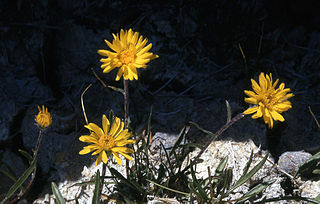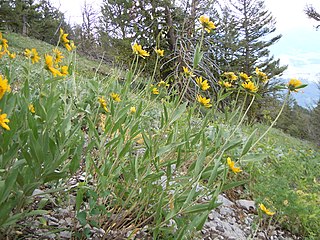
Banksia baxteri, commonly known as Baxter's banksia or bird's nest banksia, is a species of shrub that is endemic to Western Australia. It has greyish brown bark, hairy stems, deeply serrated leaves with triangular lobes and lemon-yellow flowers in an oval flower spike that grows on the end of branches.

Lambertia is a genus of flowering plants, belonging to the family Proteaceae. It is endemic to Australia. The genus was named in 1798 by Sir James Edward Smith in honour of English botanist Aylmer Bourke Lambert.

Lambertia multiflora, commonly known as many-flowered honeysuckle, is a multi-stemmed shrub which is endemic to the south-west of Western Australia. It grows to between 0.5 and 2.5 metres high and flowers from winter to summer.

Lambertia ericifolia , commonly known as heath-leaved honeysuckle, is a shrub which is endemic to the south-west of Western Australia. It grow up to 5 metres high and has orange to red flowers which appear from spring to autumn.

Clintonia uniflora, commonly known as bride's bonnet, queen's cup, or bead lily, is a species of flowering plant in the lily family Liliaceae. The specific epithet uniflora means "one-flowered", a characteristic that distinguishes this species from others in the genus Clintonia. For this reason, it is also known as the single-flowered clintonia.

Lambertia formosa, commonly known as mountain devil, is a shrub of the family Proteaceae, endemic to New South Wales, Australia. First described in 1798 by English botanist James Edward Smith, it is the type species of the small genus Lambertia. It is generally found in heathland or open forest, growing in sandstone-based soils. It grows as a multistemmed shrub to around 2 m (7 ft) with a woody base known as a lignotuber, from which it regrows after bushfire. It has stiff narrow leaves, and the pink to red flowerheads, made up of seven individual tubular flowers, generally appear in spring and summer. It gains its common name from the horned woody follicles, which were used to make small devil-figures.

Gazania rigens, sometimes called treasure flower, is a species of flowering plant in the family Asteraceae, native to coastal areas of southern Africa. It is naturalised elsewhere and is widely cultivated as an ornamental plant.

Lambertia inermis, Noongar chittick, is a shrub which is endemic to south-west Western Australia. It grows to 6 metres high and flowers from spring to winter. A more complete description is given in Florabase and Australian Flora online.

Pyrrocoma uniflora is a species of flowering plant in the family Asteraceae known by the common name plantain goldenweed. It is native to western North America from central Canada to California to Colorado, where it grows in several types of habitat, including forest and meadows with alkali soils, such as those near hot springs. It is a perennial herb growing up to 40 centimeters tall, the stems reddish and usually with a thin to thick coating of woolly fibers. The lance-shaped, toothed leaves are usually woolly, the largest near the base of the plant reaching up to 12 centimeters in length. The inflorescence is a single flower head or a cluster of a few heads, each lined with woolly phyllaries. The head contains yellow disc and ray florets. The fruit is an achene which may be over a centimeter long including its long pappus.

Baeometra is a genus in the family Colchicaceae containing a single species, Baeometra uniflora. It is native to South Africa, where it is commonly called beetle lily due to the dark markings on the tepals. The genus was erected when the British botanist Richard Salisbury described the species "Baeometra columellaris" in 1812, although the plant had already been discovered, described and painted in 1793 by the Austrian botanist Nikolaus Joseph von Jacquin under the name Melanthium uniflorum. The correct name for the species was thus settled in 1941 by the South African botanist Gwendolyn Lewis to be Baeometra uniflora (Salisb.) G.J.Lewis. The epithet means "single-flowered", which is contradicted by the fact that the stem usually bears at least two yellowish flowers.

Lambertia orbifolia, commonly known as the roundleaf honeysuckle, is a shrub or small tree that is endemic to the south-west of Western Australia. It has more or less circular leaves and groups of between four and six orange-red flowers.

Lambertia echinata, commonly known as prickly honeysuckle, is a shrub which is endemic to the south-west of Western Australia.

Lambertia ilicifolia, commonly known as the holly-leaved honeysuckle, is a shrub which is endemic to south-west Western Australia.

Silene uniflora is a species of flowering plant in the family Caryophyllaceae known by the common name sea campion.

Lambertia rariflora, commonly known as green honeysuckle, is a shrub which is endemic to the south-west of Western Australia.
Lambertia fairallii, commonly known as Fairall's honeysuckle, is a shrub which is endemic to the south-west of Western Australia.

Balduina uniflora is a North American species of plants in the sunflower family. It is native to the southeastern United States. It is the type species of Genus Balduina.

Helianthella uniflora, the oneflower helianthella, is a North American plant species in the family Asteraceae. It grows in the western United States and western Canada. It has been found from British Columbia south as far as northern Arizona and northern New Mexico.

Daviesia uniflora is a species of flowering plant in the family Fabaceae and is endemic to the south-west of Western Australia. It is a spreading or low-lying shrub with hairy branchlets, crowded egg-shaped, sharply-pointed phyllodes with the narrower end towards the base and pale yellow and purple flowers.


















